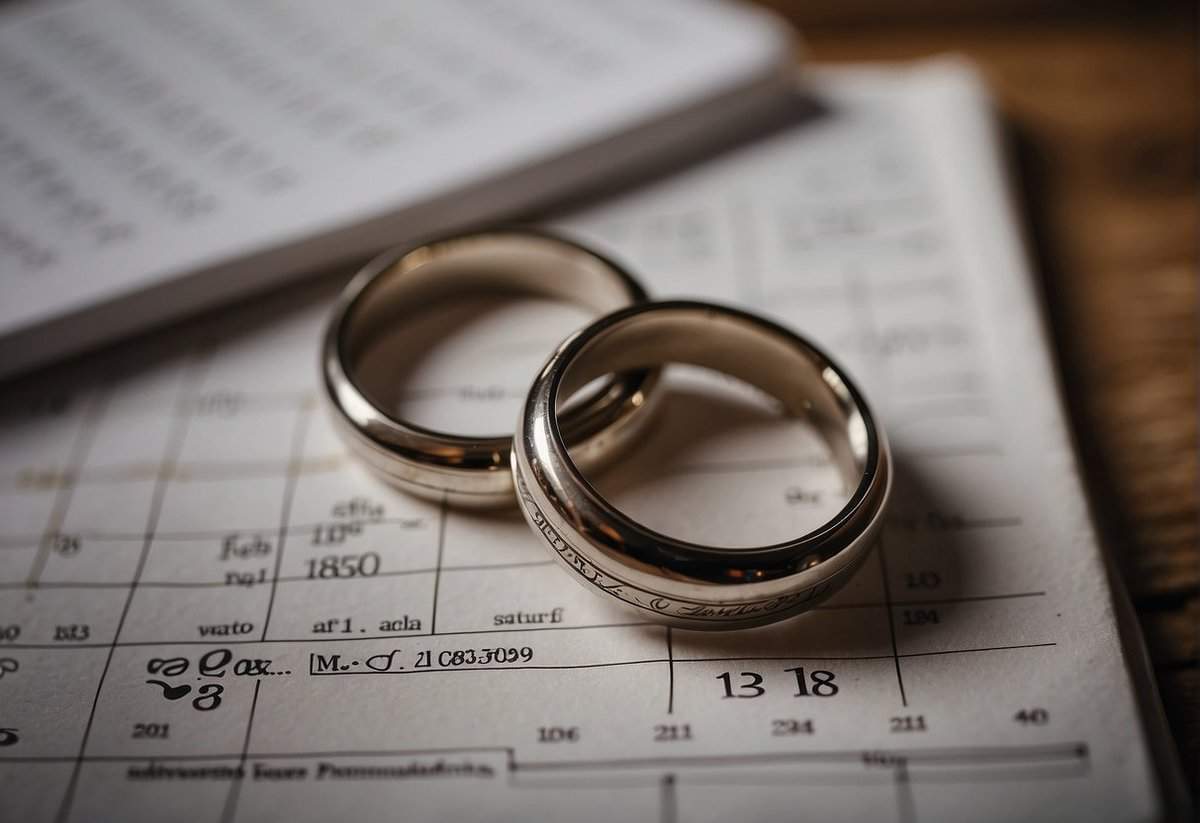What Age Do Marriages End? Understanding the Trends in Marital Longevity
The age at which marriages end can vary widely, as it is influenced by a multitude of factors, including societal trends, personal circumstances, and life events. Statistically speaking, certain ages do reveal higher instances of divorce. For example, women who marry very young or after the age of 45 are more likely to experience divorce, while the average age of individuals going through a first divorce is around 30. These nuances in divorce statistics underscore how each marriage is unique, yet also subject to broader demographic patterns.

Analyzing the length and stability of marriages across different cohorts reveals that both legal and financial considerations, alongside emotional ones, have a significant impact on the longevity of relationships. Understanding these indicators can offer insight into the complexities of marital success and the challenges that may lead to dissolution. While seeking answers about the end of marriages, it’s important to approach the topic with recognition of its sensitivity and the diverse experiences of those who have gone through it.
Key Takeaways
- Certain ages show higher divorce rates, with young marriages and those entered into after age 45 being particularly vulnerable.
- The average age for experiencing a first divorce tends to be around 30.
- The decision to divorce is influenced by a blend of demographic, legal, and financial factors.
Understanding Divorce Statistics

When you’re exploring the journey of marriages in the United States, it’s crucial to understand that divorce statistics offer a window into which factors influence marital stability. The numbers reveal patterns related to age, marriage duration, and whether it’s a first or subsequent marriage.
Age-Related Divorce Trends
Your likelihood of getting divorced can correlate with your age at the time of marriage. Research indicates that individuals who marry very young face a higher chance of divorce. Conversely, those who marry after the age of 45 also experience increased divorce rates. According to Forbes Advisor, although both marriage and divorce rates have declined over time, the trends suggest significant variability across different age groups.
Influence of Marriage Duration
The duration of your marriage can greatly affect the probability of staying together. According to Our World in Data, the longer you stay married, the lower the risk of divorce becomes. This is demonstrated by statistics showing that as the marriage crosses critical milestones such as the 10th or 20th anniversary, fewer couples end up divorcing compared to those in the earlier years of marriage.
Effects of Marriage Order
The order of your marriage also plays a significant role in its potential longevity. Data suggests that first marriages tend to have a lower divorce rate compared to subsequent marriages. The national divorce rate for second marriages is approximately 60% which then climbs for third marriages. Understanding this pattern is vital as it highlights the increased challenges that come with subsequent marriages.
Factors Contributing to Marital Breakdown

When examining why marriages may reach their endpoint, it’s critical to recognize that both personal dynamics and larger societal factors play significant roles. Let’s navigate through some of these contributing elements to better understand their impact.
Economic Influences
The strain of financial problems is a potent stressor in marriages. Poverty or ongoing money issues can create a breeding ground for tension, potentially leading to a breakdown in the relationship. Studies suggest that when men and women face economic instability, marriages may be at higher risk. In particular, financial problems can lead to a rise in conflict that escalates to irreconcilable differences.
- Substance misuse, often linked to financial hardship, can further exacerbate the risk of divorce.
- The median age at which these economic strains become severe enough to end marriages is not definitively pinpointed but is seen more frequently in the age ranges of 28 to 32 and over 45.
Social and Demographic Factors
Your marriage doesn’t exist in a bubble—it’s influenced by a variety of social and demographic factors.
- Race and ethnicity can play a role in how relationships are formed and sustained, with different cultural expectations and stressors impacting marital longevity.
- Marriages between individuals of different social and demographic backgrounds may face unique challenges.
- A more nuanced understanding of these factors is necessary when considering the common reasons for divorce in various communities.
Interestingly, statistics reveal that women tend to initiate divorce more than men, and this could tie back to evolving social norms around gender roles and expectations.
Interpersonal Dynamics
The most intimate layer of factors leading to marital breakdown lies in interpersonal dynamics—the very core of your relationship with your spouse.
- Fundamental elements such as love, commitment, respect, and the ability to manage conflicts influence the strength of a marriage.
- A lack of commitment, instances of infidelity, and domestic violence are substantial contributors to the end of a marriage. These factors are deeply personal yet remarkably common.
- When children are in the picture, the relationship becomes even more complex. Issues related to parenting can create or exacerbate existing marital problems, sometimes pushing a relationship past the point of repair.
While every marriage is unique, patterns emerge showing that internal dynamics related to commitment and respect are as influential as external pressures in deciding the fate of a relationship.
Legal and Financial Implications of Divorce

When you’re facing a divorce, it’s crucial to understand the legal process and financial outcomes, such as settlements and support that may shape your future. These aspects can have lasting impacts on your finances and well-being.
Navigating Divorce Proceedings
During divorce proceedings, you’ll encounter a range of legal requirements and decisions. The initiation of divorce requires proper filing of paperwork with the court, which can vary depending on your state’s laws. A divorce settlement is the legal agreement that divides marital assets and responsibilities. It’s often negotiated with the help of lawyers or a mediator. In scenarios where a couple can’t reach an agreement, the court will decide on the division of assets.
A sociologist may provide insights about the emotional effects of divorce, and some individuals seek therapy to cope with the stress. Understanding the legalities of a prenuptial agreement if one is in place, is important as well. This document can dictate the terms of a divorce before marriage even occurs.
Financial Settlement and Support
The financial aspects of divorce include alimony (spousal support), child support, division of property, and debt allocation, which are all part of the divorce settlement.
- Alimony: Designed to provide financial balance post-divorce, this could be a temporary or permanent arrangement.
- Child support: A monthly payment to support children’s living expenses and is often legally required.
It’s also important to consider dividing life insurance policies and updating beneficiaries accordingly. A chart from the Bureau of Labor Statistics or other reputable institution can offer a visual representation of economic factors such as the mortality rate or the economic status of individuals post-divorce, which can be crucial for financial planning.
Remarriage may also change your financial obligations, especially regarding alimony or child support. It’s wise to consult with professionals to get a clear understanding of your legal rights and financial position during and after divorce proceedings.
Frequently Asked Questions

In this section, you’ll find concise answers to common inquiries about the lifecycle of marriages and the characteristics associated with their dissolution.
At what stage in life do most divorces occur?
Typically, divorces tend to occur between the ages of 40 and 49, a period when individuals often reassess life goals and personal satisfaction in their relationships.
What is the average duration of marriage before it ends in divorce?
On average, marriages that end in divorce last about 8 years from marriage to the separation or initiation of divorce proceedings.
Which age group has the highest divorce rate?
The highest divorce rates are found among adults ages 40 to 49, with a noticeable peak in this demographic.
How often do marriages last beyond 30 years?
A significant number of marriages do last beyond 30 years, with factors like shared values, effective communication, and mutual respect often contributing to their longevity.
What is the leading reason for divorces?
Infidelity, financial stress, lack of communication, and constant conflict are among the leading reasons why couples decide to end their marriage.
Which demographics are more likely to experience divorce?
Divorce appears to be more common among individuals with lower educational attainment and those who marry younger, with comparative longevity observed in marriages where both partners have higher levels of education and marry at an older age.


